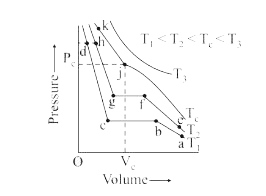Isotherms of carbon dioxide at various temperature are represented in Fig.
Answer the following questions bases of this figure.
(i) In which state will CO2 exist between the point a and b at temperature T1?
(ii) At what point will CO2 start liquefying when temperature is T1?
(iii) At what point will CO2 be completely liquified when temperature is T2.
(iv) Will condensation take places when the temperature is T3.
(v) What portion of the isotherm at T1 represents liquid and gaseous CO2 at equilibrium ?

(i) CO2 gas will exist in the gaseous state.
(ii) CO2 gas will start liquefying at point b.
(iii) CO2 will get completely liquified at point g.
(iv) No, of it is not possible T3 is higher than critical temperature (Tc).
The portion between b and c represents liquid and gaseous CO2 at equilibrium.
Topper's Solved these Questions
- STATES OF MATTER : GASES AND LIQUIDSBook:DINESH PUBLICATIONChapter:STATES OF MATTER : GASES AND LIQUIDSExercise:Concept Based Questions
Explore 32 Videos
- STATES OF MATTER : GASES AND LIQUIDSBook:DINESH PUBLICATIONChapter:STATES OF MATTER : GASES AND LIQUIDSExercise:Additional Important Questions
Explore 22 Videos
- STATES OF MATTER : GASES AND LIQUIDSBook:DINESH PUBLICATIONChapter:STATES OF MATTER : GASES AND LIQUIDSExercise:Exercise Fully Solved
Explore 23 Videos
- STATES OF MATTER (SOLID STATE CHEMISTRY)Book:DINESH PUBLICATIONChapter:STATES OF MATTER (SOLID STATE CHEMISTRY)Exercise:ULTIMATE PREPARATORY PACKAGE
Explore 21 Videos
- STRUCTURE OF ATOMBook:DINESH PUBLICATIONChapter:STRUCTURE OF ATOMExercise:Reason Type Questions
Explore 1 Video
Similar Questions
Isotherms of carbon dioxide at various temperature are represented in Fig.
Answer the following questions bases of this figure.
(i) In which state will CO2 exist between the point a and b at temperature T1?
(ii) At what point will CO2 start liquefying when temperature is T1?
(iii) At what point will CO2 be completely liquified when temperature is T2.
(iv) Will condensation take places when the temperature is T3.
(v) What portion of the isotherm at T1 represents liquid and gaseous CO2 at equilibrium ?

View SolutionIsotherms of carbon dioxide at various temperatures are represented in figure. Answer the following questions based on this figure.

In which state will CO2 exist between the points a and b at temperature T1 ?
View Solution
Knowledge Check
If two bodies at different temperatures T1 and T2 are brought in thermal contact, the mean temperature T1+T22. When
Amass of two bodies are equalBpressure on two bodies are equalCtherma capacities of two bodies are equalDvolume of two bodies are equalThe efficiency of a carnot engine working between temperature T1 and T2 is η. It will be also η if it works between temperatures
AT1+10 and T2+10BT1−10 and T2−10C2T1 and 2T2Din all the above casesCO2 at 600 bar and a temperature above Tc(Tc=304.15K) is called
Asuper cooled gasBsuper critical fluidCsuper critical liquidDsuper cooled liquid
Isotherms of carbon dioxide at various temperatures are represented in figure. Answer the following questions based on this figure.

At what point will CO2 be completely liquefied when temperature is T2 ?
View SolutionIsotherms of carbon dioxide at various temperatures are represented in figure. Answer the following questions based on this figure.

At what point will CO2 start liquefying when temperature is T1?
View SolutionIsotherms of carbon dioxide at various temperatures are represented in figure. Answer the following questions based on this figure.

Will condensation take place when the temperature is T3?
View SolutionIsotherms of carbon dioxide at various temperatures are represented in figure. Answer the following questions based on this figure.

What portion of the isotherm at T1 represent liquid and gaseous CO2 at equilibrium?
View SolutionTwo curves are given at temperatures T1andT2 in an isothermal process, then-

View Solution

